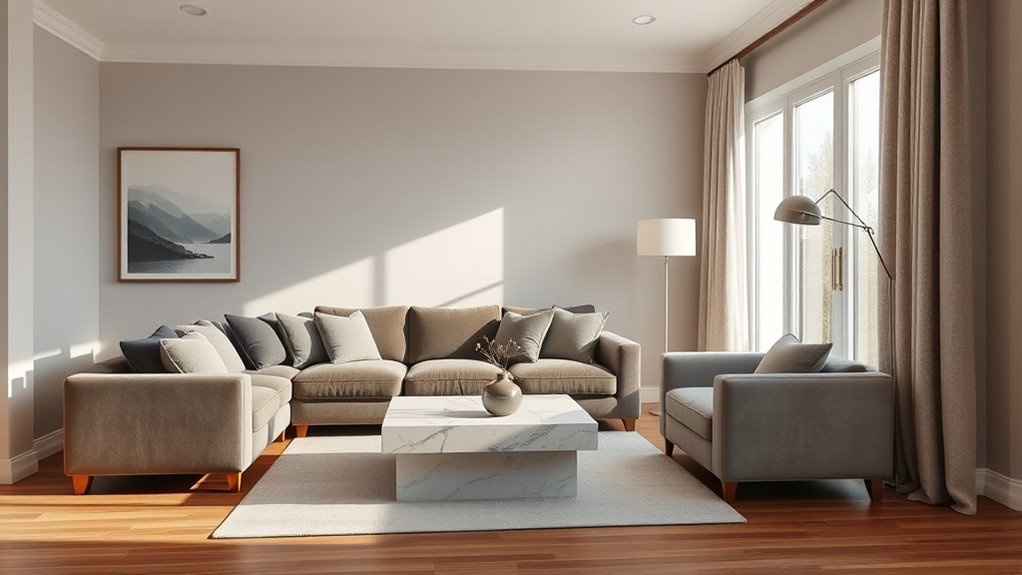To master monochromatic décor in minutes, start by choosing a color that sparks joy and reflects your personality. Use variations like shades, tints, and tones to add depth, and incorporate different textures such as velvet or wood for visual interest. Play with paint sheens—matte, semi-gloss—to highlight details, and add black accents for contrast. Layer natural materials and light to create dimension, and use darker shades sparingly for impact. Keep exploring these tips for a cohesive, stylish space.
Key Takeaways
- Choose a joyful, versatile color as your base, ensuring it aligns with your mood and personal preferences.
- Incorporate variations of your chosen hue through shades, tints, and tones for depth and visual interest.
- Use different paint sheens and finishes to add texture, contrast, and highlight architectural details effortlessly.
- Add black accents and strategic darker shades to create contrast, balance, and focal points within your monochromatic scheme.
- Layer natural materials and maximize light to introduce dimension, warmth, and a polished, cohesive look quickly.
Pick a Color That Sparks Joy
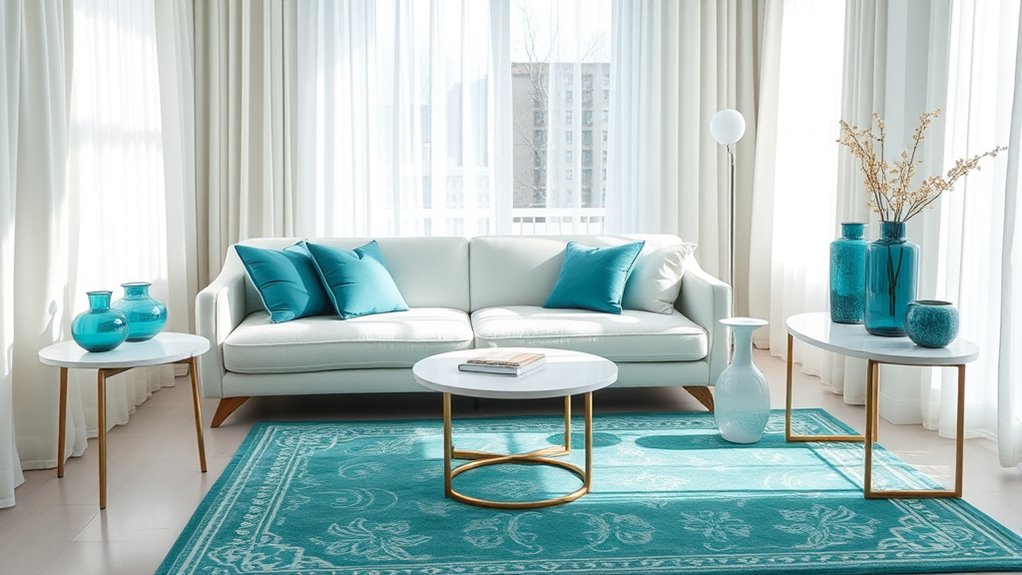
Choosing a color that sparks joy is essential for creating a monochromatic scheme you’ll love. Your chosen hue sets the tone for your entire space, so pick one that naturally evokes positive feelings and matches your personal preferences. Use artwork, wallpaper, or fabrics to see which colors consistently attract and inspire you. Look to your wardrobe for clues—shades you wear often or feel comfortable in can guide your selection. Consider the mood you want to create: deep, rich tones add sophistication, while bright hues energize the room. The key is selecting a color you’ll be happy to see every day, making your space both beautiful and sustainable. When your color sparks joy, your monochromatic décor feels authentic and inviting.
Start With Small Spaces to Build Confidence

Ever wondered how to confidently plunge into monochromatic décor? Start with small spaces like bathrooms, bedrooms, or home offices. These areas let you experiment with a monochromatic color palette without feeling overwhelmed. Using limited space helps you focus on texture variation, finishes, and accents, which are key to adding depth. Small-scale projects are perfect for confidence building because they give you hands-on experience with how different tones and materials work together. By working in confined areas, you can easily assess what feels right and refine your interior design skills. This approach aligns with interior design principles, making the process more manageable and enjoyable. Starting small makes it less intimidating to expand your monochromatic décor to larger rooms later, giving you the confidence to master this style with ease. Additionally, incorporating rustic decor elements like vintage furniture and natural materials can help you develop a cohesive look while building your confidence. Incorporating water-resistant materials can also be beneficial to ensure longevity and easy maintenance in your small décor projects. Exploring sustainable and eco-friendly options can further enhance your design while supporting environmental responsibility.
Use Variations of Your Chosen Hue
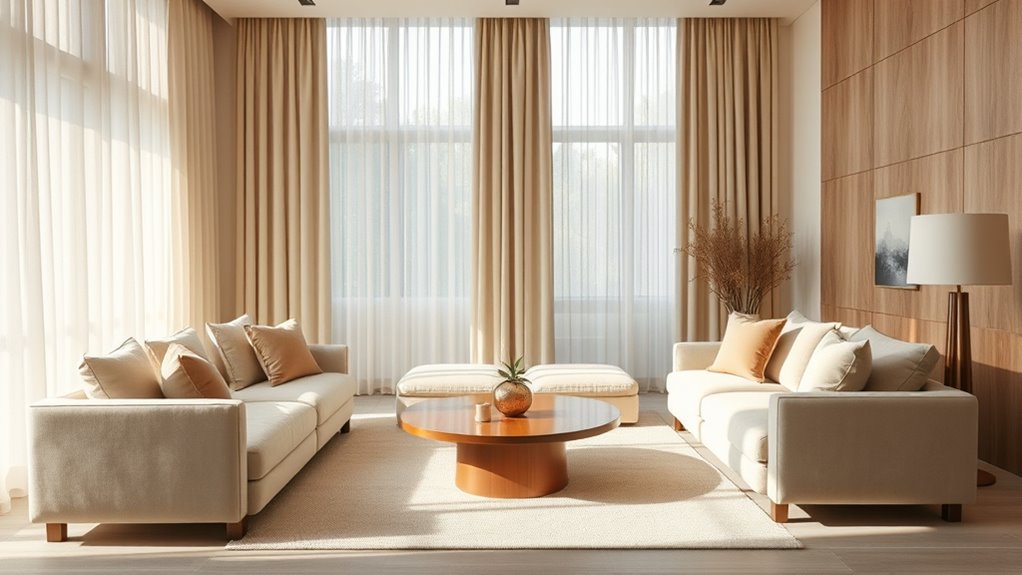
To create visual interest within a monochromatic scheme, incorporate a range of shades, tints, and tones of your chosen hue. This variation in your color palette adds depth and keeps your space engaging. Use lighter shades on walls and ceilings to evoke openness, while darker shades on furniture or accents create contrast. Layering textures and finishes—like matte, eggshell, or semi-gloss—further enhances your color variations. Exploring color palette selection can help you choose the most effective hues for your space. Additionally, understanding how light influence influences our perception can help you design more captivating and dynamic monochromatic environments. Incorporating different headphone types can also influence how you experience your space, especially when listening to music or ambient sounds during your design process. Being mindful of color psychology can further refine your choices to evoke specific moods or atmospheres.
Incorporate Textures for Visual Depth
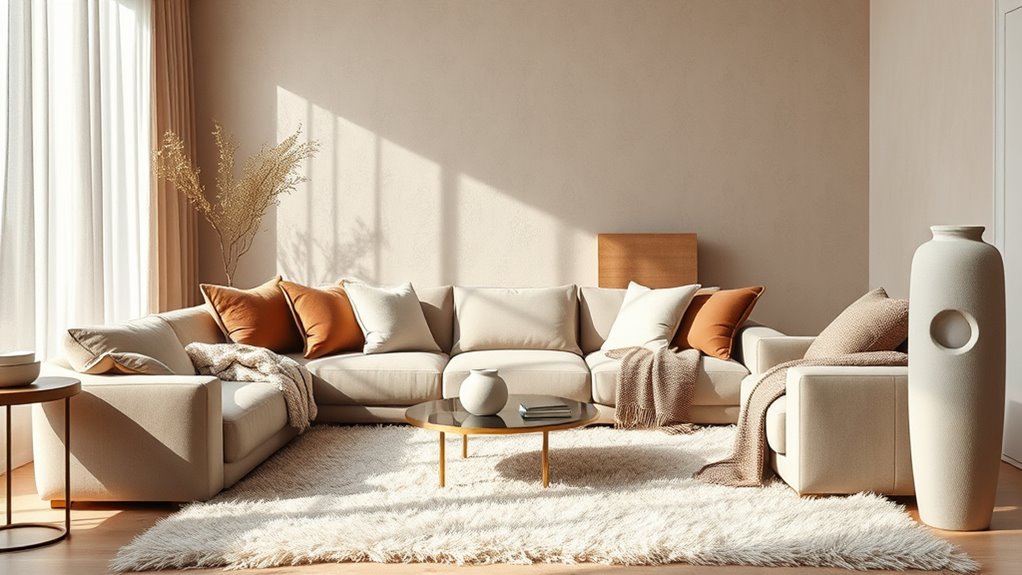
To add visual depth to your monochromatic space, incorporate a variety of textures like velvet, linen, and wool. Use textured wall treatments such as grasscloth wallpaper or embossed panels to create interest on flat surfaces. Mixing finishes and materials keeps the look dynamic and engaging without overwhelming the monochrome palette. Incorporating diverse materials made from different textures and finishes can further enhance the tactile experience and add a creative touch to your decor. Additionally, integrating natural elements like wood or stone can introduce earthy textures and promote a sense of tranquility. Understanding the importance of textural contrast can also help emphasize texture differences and create a richer visual experience.
Mix Diverse Fabrics
Mixing diverse fabrics is an effective way to add tactile richness and visual interest to a monochromatic space. By incorporating different fabric varieties like velvet, linen, wool, and silk, you create subtle texture layering that keeps the room engaging. Use textured upholstery, throw pillows, and curtains in various fabrics to build depth without changing your color palette. Combining smooth, shiny surfaces with matte or nubby textures prevents flatness and adds dimension. Natural materials such as rattan, wicker, or weathered wood further introduce organic textures that complement your monochromatic scheme. Balance soft textiles with hard surface materials like marble or textured paint finishes. This fabric mix enhances tactile interest and makes your monochromatic décor feel dynamic and inviting.
Use Textured Wall Treatments
Incorporating textured wall treatments is a powerful way to add visual depth and tactile interest to a monochromatic space. Using textured wall treatments like grasscloth, stucco, or wainscoting breaks up flat wall surfaces and enriches a monochromatic color scheme. These layered textures create subtle shadows and highlights, amplifying visual interest without disrupting the cohesive palette. Embossed wallpaper or 3D panels further enhance depth by adding dimension to the walls. Natural textures such as stone or reclaimed wood introduce earthy tones and sophistication, elevating the overall design. Combining different textured wall surfaces with varying sheens—matte, eggshell, or semi-gloss—emphasizes layers of richness, making your space feel more dynamic and inviting while maintaining a unified monochromatic aesthetic. Additionally, incorporating textured wall surfaces that complement your décor can further emphasize the depth and richness of your monochromatic scheme. Embracing modern farmhouse elements like reclaimed wood or metal accents in your textures can create a warm, rustic yet contemporary atmosphere. Incorporating interior design principles like balance and contrast can help create a harmonious yet interesting environment.
Play With Different Paint Sheens and Finishes
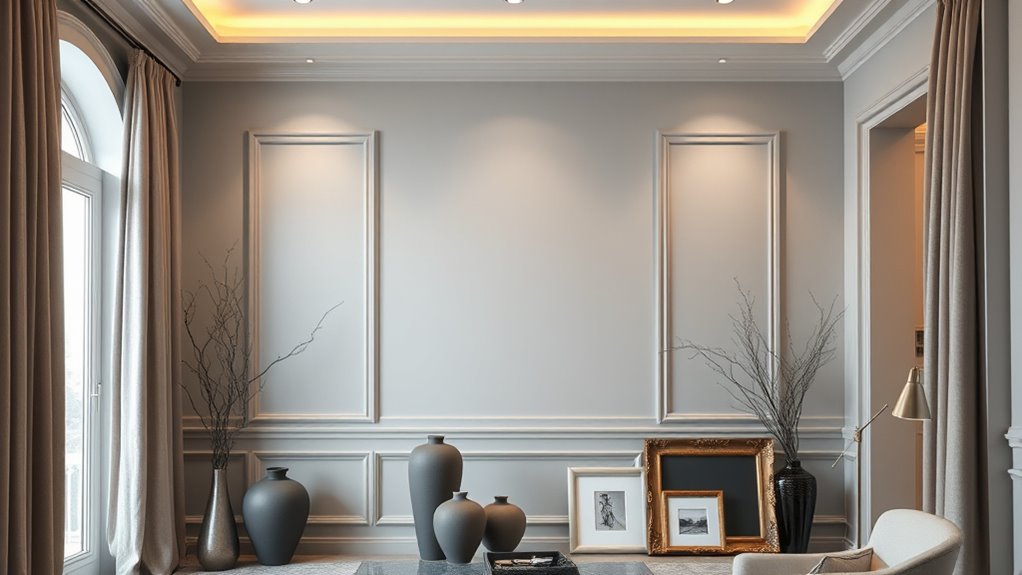
Experimenting with contrasting sheens, like matte walls and glossy trim, instantly adds depth to your monochromatic space. Mixing finishes such as satin and semi-gloss highlights architectural details and textures. By strategically combining these, you can create a dynamic and polished look that keeps the room visually interesting.
Use Contrasting Sheens
By using different paint sheens within the same monochromatic palette, you can create subtle depth and visual interest in your space. Incorporate finish contrast by applying high-sheen paints like semi-gloss or gloss on trim, moldings, or accent walls, while keeping walls in matte or eggshell finishes. This variation reflects light differently, highlighting layered tones and emphasizing architectural details. The contrast between shiny and flat surfaces adds texture and sophistication without disrupting the monochromatic scheme. Strategically selecting finishes balances durability and aesthetic appeal—eggshell helps hide imperfections on walls, while semi-gloss offers easy cleaning on trims. Playing with contrasting sheens allows you to craft a dynamic, refined look that elevates your monochromatic décor with minimal effort. Additionally, understanding interior design principles can help you balance form and function, much like how contrasting finishes protect and enhance your physical décor.
Mix Matte and Gloss
Mixing matte and gloss finishes within a monochromatic palette instantly adds visual interest and highlights architectural details. Using a matte finish on walls creates a soft, understated background, reducing glare and emphasizing texture. Applying a gloss finish on trim and moldings adds subtle shine, drawing attention to architectural details. To enhance your space:
- Use matte finishes on large surfaces to keep the room calm and cohesive.
- Highlight architectural features with gloss finishes on trim, moldings, or accents.
- Apply gloss to select furniture or decorative pieces for depth and focus.
- Combine different sheens to create visual contrast and add dimension without overwhelming the space.
- Incorporate beach-inspired colors to evoke a calming, coastal atmosphere that complements the textured finishes.
Choose high-quality paints to guarantee durability and maintain the distinct textures of matte and gloss finishes over time.
Add Black Accents for Balance and Contrast

Adding black accents is a simple yet effective way to create balance and contrast in a monochromatic space. By incorporating black accents through picture frames, lamps, or small furniture pieces, you ground your monochromatic décor and add visual interest. Use black in gallery walls or decorative accessories to instantly draw the eye and create striking contrast. Applying black to furniture frames or trim unifies the space while adding depth and sophistication. Black accents serve as a subtle, unifying thread that balances lighter shades, preventing your décor from feeling flat. Strategically placing black elements introduces contrast and a modern, elegant touch, elevating your monochromatic scheme. This simple addition ensures your space feels cohesive, dynamic, and visually compelling.
Find the Perfect Undertones for Warmth
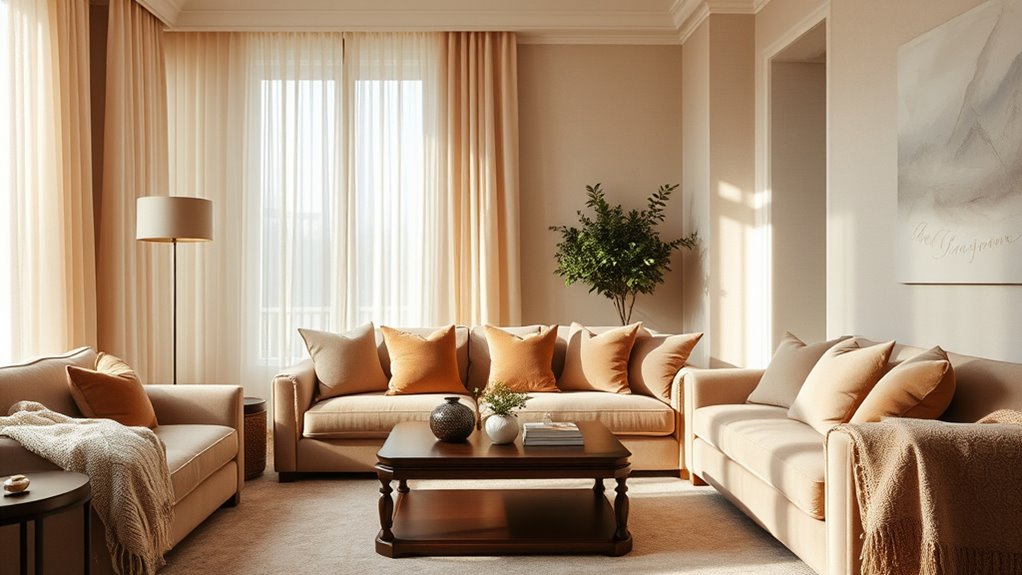
Choosing the right undertones, like pink or beige, instantly adds warmth and depth to your monochromatic space. When you match warm tones with fixtures and materials, everything feels more cohesive and inviting. Pay attention to subtle hints of yellow, red, or orange to guarantee your colors radiate cozy comfort.
Warmth Through Color Tones
To create a warm and inviting monochromatic space, focus on selecting paint colors with genuine warm undertones. These undertones—like beige, peach, or golden hues—instantly add coziness and depth to your color scheme. Layering warm undertones such as pink, coral, or warm gray with textured accessories can deepen the sense of comfort and visual richness. Natural materials like oak, marble with beige or caramel veining, and weathered wood enhance warmth when paired with these tones. Proper lighting, such as warm LED bulbs or soft ambient fixtures, amplifies the warmth through color. To get it right, consider:
- Choosing colors with yellow, red, or golden hints for warmth.
- Incorporating textured textiles that reflect these tones.
- Using natural materials to elevate the warmth.
- Adjusting lighting to enhance the cozy atmosphere.
Matching Fixtures for Cohesion
Matching fixtures for cohesion guarantees your monochromatic space feels unified and polished. To achieve this, select fixtures with undertones that complement your wall and furniture colors. Warm undertones, like brass or gold, add an inviting glow that enhances warm-colored walls and decor elements. For a harmonious look, opt for fixtures with subtle undertones—creamy whites or warm grays—that align with your primary color palette. Properly matching the undertones of your fixtures helps prevent visual discord, especially when layering different textures and materials within a monochromatic scheme. Conducting a color undertone test under natural light ensures your fixtures truly harmonize with your overall color palette, creating a seamless, cohesive look that elevates your monochromatic décor.
Layer Natural Materials and Light for Dimension

Layering natural materials and light in a monochromatic space creates rich visual interest and depth. By incorporating natural textures like marble, stone, and wood into furniture and accessories, you add subtle dimension within your monochromatic palette. To maximize natural light, include large windows, reflective surfaces, and light-colored drapes that brighten the room and highlight layered textures. Consider these tips:
- Use layered materials such as rattan, wool, and linen within the same color family.
- Combine warm and cool natural tones like taupe and slate gray for depth.
- Place natural light sources strategically to create shadows and highlights.
- Incorporate reflective finishes to enhance natural illumination and emphasize textures.
This approach will deepen your décor’s visual interest while maintaining harmony through natural materials and light.
Use Darker Shades Sparingly for Impact

In a monochromatic space, incorporating darker shades can create striking focal points, but it’s essential to use them sparingly to maintain balance. Darker shades work best as accent walls or furniture pieces, adding visual interest without overwhelming the room. Limit their use to about 20-30% of your color scheme to keep the space light and cohesive. You can also add contrast by applying darker shades to trim, door frames, or small accessories, which enhances depth without cluttering the look. Pair these deep hues with lighter tones of the same color to create harmony. For added richness, opt for textured finishes like matte or velvety surfaces. Using darker shades carefully ensures your décor remains balanced, vibrant, and engaging.
Draw Inspiration From Natural Elements
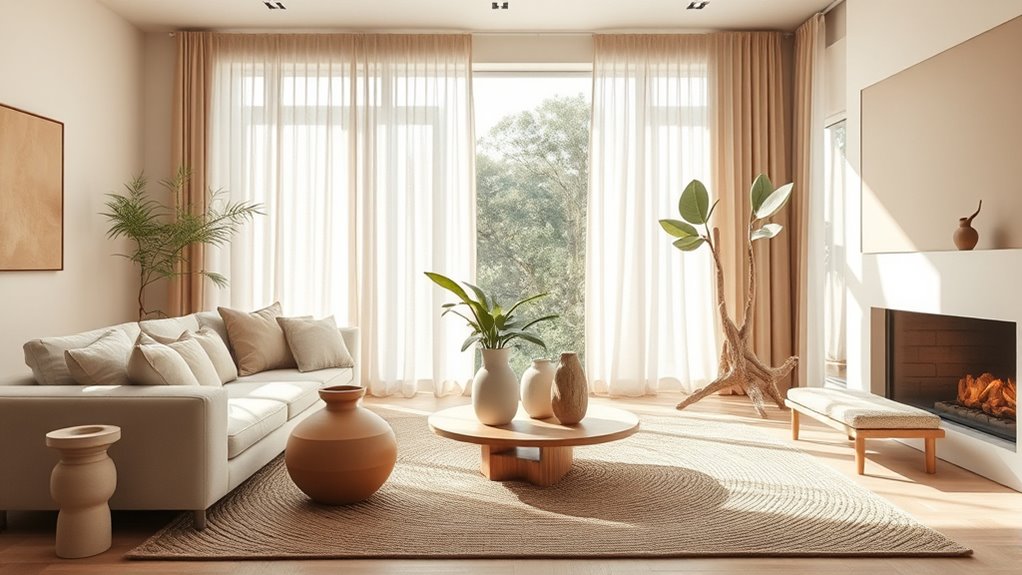
Natural elements like stone, marble, and wood offer authentic monochromatic palettes that bring depth and sophistication to your space. These organic materials feature subtle variations in tone, creating a harmonious design that feels both calming and refined. To incorporate natural textures effectively, consider these ideas:
Embrace natural textures like stone, marble, and wood for sophisticated, harmonious interiors with subtle tonal variations.
- Use slate gray or beige marble for walls or countertops to add subtle color palettes with visual interest.
- Incorporate warm oak or weathered wood furniture to introduce organic textures that enhance tactile depth.
- Mix natural materials like rattan or stone with monochromatic paint to achieve a cohesive, layered look.
- Draw inspiration from mineral palettes for multidimensional interiors that celebrate organic beauty through subtle color gradations.
Frequently Asked Questions
What Is the Monochromatic Color Rule?
The monochromatic color rule involves using different shades, tints, and tones of a single hue to create a cohesive and harmonious space. You select a primary color and layer lighter or darker variations to add depth and interest. To keep it engaging, incorporate varied textures and finishes. This approach makes your decor look sophisticated and balanced, while avoiding flatness or monotony through thoughtful manipulation of the same color family.
How to Decorate Monochromatic?
To decorate monochromatically, start by choosing a primary color that makes you feel good and fits your mood. Gather different shades, tints, and tones of that color. Use lighter shades on walls and ceilings for openness, darker shades for furniture and accents to add depth. Mix textures like matte and gloss, and add small contrasting accents. Balance everything with black or metallic details to create a cohesive, stylish space.
What Is the Monochrome Color Technique?
The monochrome color technique involves using just one hue, but with different shades, tints, and tones to create a cohesive look. You layer lighter, darker, and muted variations of the same color to add depth and visual interest. This approach emphasizes harmony and subtle contrast, making your space feel sophisticated. By mixing textures and finishes, you can easily adapt this versatile method to suit any style or mood.
How Do You Break up a Monochromatic Room?
Imagine you’re sailing a ship in a sea of one color—you need landmarks. To break up a monochromatic room, you add contrasting textures like matte walls with glossy furniture, and use accent accessories in different shades or finishes. Incorporate layered textiles and subtle patterns, and vary darker and lighter shades throughout. Architectural details, furniture placement, and segmented arrangements create visual landmarks, making the space dynamic and engaging, even within a single color palette.
Conclusion
By choosing a joyful color, building confidence with small spaces, and experimenting with textures and shades, you create a cohesive and mesmerizing monochromatic look. Embrace natural elements, play with light, and add depth with subtle contrasts. Let your space reflect your personality, your style, and your taste. With these simple steps, you’ll master monochromatic décor quickly, confidently, and beautifully—making every room a reflection of your unique vision and a space you love to live in.
